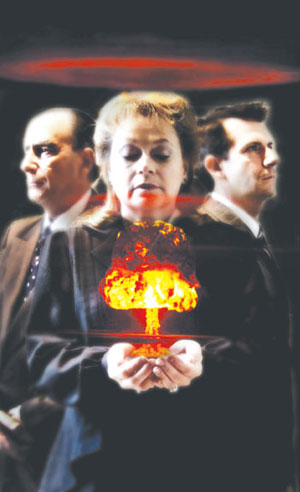At the height of World War II, in the tiny occupied nation of Denmark, two great minds came together, at great risk and under the eye of the Gestapo, to discuss the potential of creating the most destructive weapon the world had ever known.
Danish physicist Niels Bohr and his German counterpart and former student, Werner Heisenberg, were former friends and colleagues who found themselves on opposite sides of a world war. Each would have a major role in their respective side’s attempt to turn nuclear fission into a weapon that would guarantee an end to the chaos and suffering of World War II.
It is these men who create the nucleus of Michael Frayn’s play “Copenhagen,” currently playing at The American Repertory Theatre’s Loeb Drama Center. Alongside Bohr and Heisenberg is Bohr’s wife Margrethe who begins the play by disturbing the relative peace of the afterlife that she shares with her husband by questioning Heisenberg’s motivation for his oft-debated 1941 trip to the couple’s home in Copenhagen. The mysterious events are then relived by the Bohrs and by Heisenberg.
Under restrictions of the Nazi regime, and with the Gestapo a constant specter lurking in the background, Heisenberg, the head of the German nuclear energy project, travels back to the home where he had been treated like a son before the Nazis’ rise to power. Upon arrival, Heisenberg is greeted by the Bohrs with a mixture of happiness and suspicion.
This trip has been the center of much debate among both scientists and historians, and the question of Heisenberg’s true purpose remains unanswered. Frayn attempts piece together the various accounts of the visit in order to make sense of it all.
The play contains a heap of physics and a megaton of scientific jargon, as well as considerable name dropping. As the old friends reminisce about other early physicists, the tension remains high, and the one-time peers cautiously probe one another, each wondering if they can trust the other. Heisenberg questions whether Bohr has been in contact with the allies, while Bohr and his wife question whether Heisenberg is spying for the Nazi government.
The father-son dynamic between the two men is the most interesting aspect of the play, and the constant presence of “the bomb” and the war as backdrops only add to the tension. Director Scott Zigler has called the play “an illustration of how deeply personal dynamics interweave with momentous events.” This theme is not lost, but it unfortunately recedes to the background as more name dropping and scientific terminology is forced on the viewer.
At times the play regresses into excessively intellectual discussions about physics, which, when coupled with the fast-paced dialog, will leave the average audience member scratching their head and struggling to follow all of the technical mumbo jumbo. Such is the case when Heisenberg and Bohr discuss fast and slow neutrons for fifteen minutes. Making matters worse is the excruciating repetitiveness, which in the end comes to no real conclusion about what Heisenberg’s visit was all about.
Despite the promising premise, “Copenhagen” is ultimately a disappointment. Only the three mentioned characters are portrayed-although many more are mentioned. They are each on stage at all times, dressed in drab gray clothing. The costumes match the set and its only props: three chairs painted in a flat gray. Frayn has created a play that someone with an intellectual or historical curiosity about physics or the development of the atomic bomb may enjoy, but the average audience member seems to have been left out of the equation.
Copenhagen
Writer: Michael FraynDirector: Scott ZiglerWhen: Jan. 5 – Feb. 3Where: Loeb Drama Center, 64 Brattle St., Cambridge Tickets: Students: $25, General Admission: $39-79Reservations: 617-547-8300 or www.amrep.org





















































